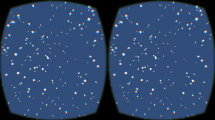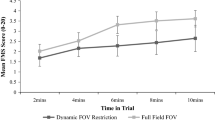Abstract
Accurately perceiving the gravitational direction is key to successful interaction in our terrestrial environment. In this context field dependence (FD), the importance given to static and/or dynamic visual cues has largely been discussed. Although first considered a trait, several studies suggest FD be flexible in response to postural or visual contexts and to poor virtual reality user experience. The aim of this study was therefore to determine the influence of a disruptive virtual immersion on the level of static and dynamic FD. Forty-five participants were exposed to a virtual maritime environment for up to 14 min. Cybersickness and sense of presence were measured. Before and after virtual immersion, the rod and frame test and the rod and disk test were performed to assess static and dynamic FD, respectively. We demonstrated a significant decrease in both levels of FD after immersion in initially more dependent participants. Decrease in static FD was explained by high initial static FD and severe cybersickness, while decrease in dynamic FD was only explained by the initial level of dynamic FD. In this study, we provide evidence confirming FD flexibility, likely reflecting an adaptation process to environmental or individual-related constraints. Yet, static and dynamic FD seems to rely on separate mechanisms, highlighting the necessity to specify which characteristic of visual information (static or dynamic) individuals depend on when assessing their FD. Our results question the reliability of virtual reality for perceptive or motor diagnoses without considering its consequences, specifically in vulnerable populations such as the elderly.





Similar content being viewed by others
Data availability statement
The datasets generated during and/or analyzed during the current study are available on figshare, by following this link: https://doi.org/10.6084/m9.figshare.19619589.v1.
References
Bockelman P, Lingum D (2017) Factors of cybersickness. In Stephanidis C (ed) HCI international — posters’ extended abstracts, vol 714, p 3‑8, Springer, Berlin. https://doi.org/10.1007/978-3-319-58753-0_1,
Bouchard S, Robillard G, Renaud P (2007) Revising the factor structure of the simulator sickness questionnaire. Annu Rev Cyberther Telemed 5(Summer):128–137
Bos JE, Bles W, Groen EL (2008) A theory on visually induced motion sickness. Displays 29(2):47–57. https://doi.org/10.1016/j.displa.2007.09.002
Bray A, Subanandan A, Isableu B, Ohlmann T, Golding JF, Gresty MA (2004) We are most aware of our place in the world when about to fall. Curr Biol 14(15):R609–R610. https://doi.org/10.1016/j.cub.2004.07.040
Brenet F, Ohlmann T, Marendaz C (1988) Interaction vision/posture lors de la localisation d’une cible enchâssée. Bull Psychol 388:22–30
Bringoux L, Scotto Di Cesare C, Borel L, Macaluso T, Sarlegna FR (2016) Do visual and vestibular inputs compensate for somatosensory loss in the perception of spatial orientation? Insights from a deafferented patient. Front Hum Neurosci. https://doi.org/10.3389/fnhum.2016.00181
De Leo G, Diggs LA, Radici E, Mastaglio TW (2014) Measuring sense of presence and user characteristics to predict effective training in an online simulated virtual environment. Simul Healthc 9(1):1–6
Dichgans J, Brandt T (1978) Visual-vestibular interaction: effects on self-motion perception and postural control. In: Perception, pp 755–804. Springer, Berlin
Dichgans J, Held R, Young LR, Brandt T (1972) Moving visual scenes influence the apparent direction of gravity. Science 178(4066):1217–1219. https://doi.org/10.1126/science.178.4066.1217
Golding JF (2006) Predicting individual differences in motion sickness susceptibility by questionnaire. Personal Individ Differ 41(2):237–248. https://doi.org/10.1016/j.paid.2006.01.012
Guerraz M, Poquin D, Ohlmann T (1998) The role of head-centric spatial reference with a static and kinetic visual disturbance. Percept Psychophys 60(2):287–295. https://doi.org/10.3758/BF03206037
Hecht D, Reiner M (2007) Field dependency and the sense of object-presence in haptic virtual environments. Cyberpsychol Behav 10(2):243–251. https://doi.org/10.1089/cpb.2006.9962
Isableu B, Ohlmann T, Crémieux J, Amblard B (1998) How dynamic visual field dependence–independence interacts with the visual contribution to postural control. Hum Mov Sci 17(3):367–391. https://doi.org/10.1016/S0167-9457(98)00005-0
Isableu B, Ohlmann T, Cremieux J, Vuillerme N, Amblard B, Gresty MA (2010) Individual differences in the ability to identify, select and use appropriate frames of reference for perceptuo-motor control. Neuroscience 169(3):1199–1215. https://doi.org/10.1016/j.neuroscience.2010.05.072
Keshavarz B, Hecht H (2011) Validating an efficient method to quantify motion sickness. Hum Factors J Hum Factors Ergon Soc 53(4):415–426. https://doi.org/10.1177/0018720811403736
Mahboobin A, Loughlin PJ, Redfern MS, Sparto PJ (2005) Sensory re-weighting in human postural control during moving-scene perturbations. Exp Brain Res 167(2):260–267. https://doi.org/10.1007/s00221-005-0053-7
Maneuvrier A, Decker LM, Renaud P, Ceyte G, Ceyte H (2021) Field (In)dependence flexibility following a virtual immersion is associated with cybersickness and sense of presence. Front Virtual Real 2:706712. https://doi.org/10.3389/frvir.2021.706712
Messick S (1976) Individuality in learning. Jossey-Bass
Niehof N, Perdreau F, Koppen M, Medendorp WP (2019) Contributions of optostatic and optokinetic cues to the perception of vertical. J Neurophysiol 122(2):480–489. https://doi.org/10.1152/jn.00740.2018
Ohlmann T (1988) La perception de la verticale. Variabilité interindividuelle dans la dépendance à l’égard des référentiels spatiaux. Université de Paris VIII
Ohlmann T (1990) Evocabilité différentielle des référentiels spatiaux, posture et orientation spatiale. Pratiques sportives et modélisation du geste, 215–240.
Ohlmann T, Marendaz C (1991) Vicarious processes involved in selection/control of frames of reference and spatial aspects of field dependence-independence. In: Wapner S, Demick J (eds) Field dependence-independence: cognitive style across life Span. Publisher Hillsdale, New Jersey, pp 105–129
Pavlou M, Quinn C, Murray K, Spyridakou C, Faldon M, Bronstein AM (2011) The effect of repeated visual motion stimuli on visual dependence and postural control in normal subjects. Gait Posture 33(1):113–118. https://doi.org/10.1016/j.gaitpost.2010.10.085
Rebenitsch L, Owen C (2016) Review on cybersickness in applications and visual displays. Virtual Real 20(2):101–125. https://doi.org/10.1007/s10055-016-0285-9
Reuchlin M (1978) Processus vicariants et différences individuelles. J De Psychol 2:133–145
Robillard G, Bouchard S, Renaud P, Cournoyer LG (2002) Validation canadienne-française de deux mesures importantes en réalité virtuelle: l’Immersive Tendencies Questionnaire et le Presence Questionnaire. Poster presented at the 25e congrès annuel de la Société Québécoise pour la Recherche en Psychologie (SQRP), Trois-Rivières
Shafer DM, Carbonara CP, Korpi MF (2017) Modern virtual reality technology: cybersickness, sense of presence, and gender. Media Psychol Rev 11(2):1
Souchet AD, Philippe S, Lourdeaux D, Leroy L (2021) Measuring visual fatigue and cognitive load via eye-tracking while learning with virtal reality head-mounted displays: a review. Int J Hum-Comput Interact, 1–24.
Stanney K, Fidopiastis C, Foster L (2020) Virtual reality is sexist: but it does not have to be. Front Robot AI 7:4. https://doi.org/10.3389/frobt.2020.00004
Tinajero C, Páramo MF (1998) Field dependence-independence cognitive style and academic achievement: a review of research and theory. Eur J Psychol Educ 13(2):227–251. https://doi.org/10.1007/BF03173091
Ukai K, Howarth PA (2008) Visual fatigue caused by viewing stereoscopic motion images: background, theories, and observations. Displays 29(2):106–116
Vallerand RJ (1989) Vers une méthodologie de validation trans-culturelle de questionnaires psychologiques : Implications pour la recherche en langue française. Can Psychol 30(4):662–680. https://doi.org/10.1037/h0079856
Weech S, Calderon CM, Barnett-Cowan M (2020) Sensory down-weighting in visual-postural coupling is linked with lower cybersickness. Front Virtual Real 1:10. https://doi.org/10.3389/frvir.2020.00010
Weech S, Kenny S, Barnett-Cowan M (2019) Presence and cybersickness in virtual reality are negatively related: a review. Front Psychol 10:158. https://doi.org/10.3389/fpsyg.2019.00158
Witkin HA, Asch SE (1948) Studies in space orientation. IV. Further experiments on perception of the upright with displaced visual fields. J Exp Psychol 38(6):762–782. https://doi.org/10.1037/h0053671
Witkin HA, Goodenough DR, Karp SA (1967) Stability of cognitive style from childhood to young adulthood. J Pers Soc Psychol 7(3):291–300. https://doi.org/10.1037/h0025070
Barrett GV, Thornton CL (1968) Relationship between perceptual style and simulator sickness. J Appl Psychol 52:304–308. https://doi.org/10.1037/h0026013
Fulvio JM, Ji M, Rokers B (2021) Variations in visual sensitivity predict motion sickness in virtual reality. Entertain Comput 38:100423. https://doi.org/10.1016/j.entcom.2021.100423
Isableu B, Ohlmann T, Crémieux J, Amblard B (1997) Selection of spatial frame of reference and postural control variability. Exp Brain Res 114:584–589. https://doi.org/10.1007/PL00005667
Maneuvrier A, Decker LM, Ceyte H, et al (2020) Presence Promotes Performance on a Virtual Spatial Cognition Task: Impact of Human Factors on Virtual Reality Assessment. Front Virtual Real 1:571713. https://doi.org/10.3389/frvir.2020.571713
Rebenitsch L, Owen C (2021) Estimating cybersickness from virtual reality applications. Virtual Real 25:165–174. https://doi.org/10.1007/s10055-020-00446-6
Funding
No funds, grants, or other support was received.
Author information
Authors and Affiliations
Contributions
HC conceived and designed the experiment. LF conducted the experiment, collected and processed the data. All authors analyzed and discussed the results, wrote, reviewed and approved the manuscript.
Corresponding author
Ethics declarations
Conflict of interests
The authors have no relevant interests to disclose.
Additional information
Publisher's Note
Springer Nature remains neutral with regard to jurisdictional claims in published maps and institutional affiliations.
Rights and permissions
Springer Nature or its licensor holds exclusive rights to this article under a publishing agreement with the author(s) or other rightsholder(s); author self-archiving of the accepted manuscript version of this article is solely governed by the terms of such publishing agreement and applicable law.
About this article
Cite this article
Fantin, L., Ceyte, G., Maïni, E. et al. Do individual constraints induce flexibility of visual field dependence following a virtual immersion? Effects of perceptive style and cybersickness. Virtual Reality 27, 917–928 (2023). https://doi.org/10.1007/s10055-022-00703-w
Received:
Accepted:
Published:
Issue Date:
DOI: https://doi.org/10.1007/s10055-022-00703-w




